|
.
Moore "fled westwards as soon
as he got news that Napoleon
was on the march"
- Charles Esdaile
|

“The English are running away
as fast as they can.”
- Napoleon
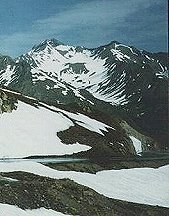 Realising what Moore had in mind, the Emperor saw a golden opportunity to swing into his rear,
while Soult contained him frontally. The British army would be encircled and destroyed.
Realising what Moore had in mind, the Emperor saw a golden opportunity to swing into his rear,
while Soult contained him frontally. The British army would be encircled and destroyed.
Napoleon took his army towards the Guadarrama Pass and in appalling weather
led through the mountains. He believed that Moore's communications stretched back from
Valladolid and along the Douro. But Moore's army was actually further north.
Napoleon ordered Lahoussaye's cavalry to scout westward toward Salamanca.
The VIII Corps and Lorge's dragoon division were assigned to Soult, who was instructed
to maneuver to fix the English while Napoleon cut them off from Salamanca.
Napoleon had decided that the appearance of British infantry in Valladolid would be
a good indication that Moore was in earnest, and he therefore would remain in Madrid until
this was reported. When the report reached him that afternoon, he ordered Lapisse,
Dessoles and part of his Guard to march at once.
It seemed obvious that Moore had changed bases and that Soult might be in considerable danger. However by hard marching, he hoped to
overtake and destroy Moore.
Napoleon's crossing of the Sierra Guadarrama.
Napoleon walked 8 miles up the steepest part of the pass,
arm in arm with his soldiers. Lapisse's infantrymen
"exasperated by fatigue, shouted insults as he passed."
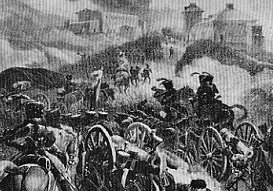 In the Sierra Guadarrama the French were struck by a terrible blizzard, the cavalry was forced
to dismount, and when the snow turned to rain the infantrymen were struggling through deep mud.
Coignet remembers fording a freezing river and emerging with his legs "as red as lobsters".
In the Sierra Guadarrama the French were struck by a terrible blizzard, the cavalry was forced
to dismount, and when the snow turned to rain the infantrymen were struggling through deep mud.
Coignet remembers fording a freezing river and emerging with his legs "as red as lobsters".
Napoleon walked 8 miles up the steepest part of the pass, arm in arm with his
soldiers. Lapisse's infantrymen "exasperated by fatigue, shouted insults as he passed."
Ney's corps cavalry lacked the strength for long-range reconnaissance through this broken
country. Though it found Salamanca evacuated, thus confirming Napoleon's deduction that
Moore had given up Lisbon for another base, farther north, it also reported the English no
farther ahead than Valladolid.
Napoleon felt so hopeful that - while ordering Ney to seize the Tordesillas Bridge - he wrote
to Joseph to have Madrid papers publish the news that
"20,000 English are cornered and doomed." The actual situation was considerably different.
Moore was reported nearing Valladolid,
and La Romana advancing from Leon. On 21st British cavalry surprised and defeated Debelle at
Sahagun. Learning that Ney had reached Tordesillas, Soult ordered an advance through Sahagun
to fix the enemy, while Ney came in on their flank and rear.
Napoleon feared that the English
might flee before he brought them to battle.
It was extremely fortunate for Moore that the Emperor
found it as difficult as he did to get accurate information
of British movements.
The British had far better knowledge of the French positions
"due to the [Spanish] guerillas' capture of large numbers of
French couriers." Esdaile - "The Peninsular War"
 Had Moore been at Valladolid, his army would have been destroyed.
It was extremely fortunate for Moore that the Emperor found it as difficult as he did to get
accurate information of enemy movements and that he was 50 miles further than his enemy
supposed.
Had Moore been at Valladolid, his army would have been destroyed.
It was extremely fortunate for Moore that the Emperor found it as difficult as he did to get
accurate information of enemy movements and that he was 50 miles further than his enemy
supposed.
The British had far better knowledge of the French positions. "If Moore's operations were
being conducted with a sure grasp of the positions and intentions of the enemy, it was in
large part due to the guerillas' capture of large numbers of French couriers. Not until 15 December was Soult informed that Moore was on
the move, whilst Napoleon did not hear of the matter for another 4 days."
(Esdaile - "The Peninsular War" p 148)
Napoleon learned about Moore's presence at Sahagun area, but his own troops were so exhausted
that he had allowed them to rest most of the 26th.
On the next day Napoleon sent his army forward at daybreak, Marshal Ney leading.
Unfortunately, worried that Soult might be too weak to resist a major offensive, he
directed Ney toward Medina-de-Rio-Seco, instead of Benavente. By the 28th, with English
infantry reported in Benavente, it was evident that Moore was retreating.
Napoleon feared that the English might flee before he brought them to battle.
Still hopeful of striking Moore's flank, he drove his troops forward along roads
knee-deep in mud, galloping ahead of them with a small escort in his anxiety to
determine whether Moore were retiring through Astorga or Zamora.
During the 28th and 29th, he checked his infantry along the flooded Esla River, awaiting the outcome of his
cavalry reconnaissances - which proved disappointing. Ney's cavalry could not find a ford.
La Romana's troops were defeated at Mansilla and were compelled to relinquish Laon.
La Romana's corps joined the British in Astorga.
Small Combat at Benavente.
Despite the moral-boosting success in this combat,
Moore's retreat towards the sea continued.
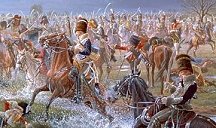 At Benavente a small French cavalry force was ambushed and defeated by the British and German cavalry.
French General Lefebvre-Desnouettes crossed the river with 600 cavalrymen and impetuously attacked the British and German cavalry.
The enemy at first gave way. General Stewart soon brought in more cavalry. The French continued advancing,
until Lord Paget, accompanied by a hussar regiment forced them to re-cross the river.
The British-German cavalry captured 70-100 prisoners, incl.Lefebvre-Desnouettes.
Despite the moral-boosting success in this small combat, Moore's retreat towards the sea continued.
At Benavente a small French cavalry force was ambushed and defeated by the British and German cavalry.
French General Lefebvre-Desnouettes crossed the river with 600 cavalrymen and impetuously attacked the British and German cavalry.
The enemy at first gave way. General Stewart soon brought in more cavalry. The French continued advancing,
until Lord Paget, accompanied by a hussar regiment forced them to re-cross the river.
The British-German cavalry captured 70-100 prisoners, incl.Lefebvre-Desnouettes.
Despite the moral-boosting success in this small combat, Moore's retreat towards the sea continued.
Soult, meanwhile, maintained the pressure
on the fleeing British corps.
"… the enemy close at our heels,
thirsting for our blood !" - W. Green of 95th Rifles.
The French advance guard encountered
evidence of the British's mounting demoralization.
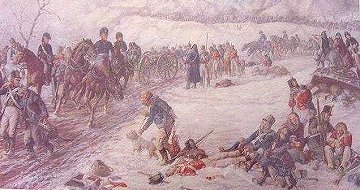 Many British units' morale cracked once the headlong retreat began.
Everywhere, Soult's advance guard encountered evidence of the British's mounting
demoralization; the roads were littered with wagons, supplies, equipment, weapons and
scores of stragglers who were captured at every turn.
Many British units' morale cracked once the headlong retreat began.
Everywhere, Soult's advance guard encountered evidence of the British's mounting
demoralization; the roads were littered with wagons, supplies, equipment, weapons and
scores of stragglers who were captured at every turn.
Sullen, the British treated Galicia like a hostile country.
Moore writes: “The people run away, the villages are deserted, and I have been obliged to
destroy great part of the ammunition and military stores. For the same reason I am obliged
to leave the sick. In short, my sole object is to save the Army.”
Almost every village which the British infantry passed, a cavalry officer of the rearguard
reported, ‘exhibited melancholy proofs of the shameful devastation committed by the infantry
which had preceded us; we observed in flames whilst we were at a considerable distance, and
it was still burning when we passed through it.
The inhabitants shouted ‘Viva los Francesces! and we overtook some stragglers who had been
stripped and maltreated by the Spaniards. The Spaniards rang their church bells to evince their
gratitude to God for having got rid of such a bunch of heretics and vandals.
According to General Stewart the Spaniards "… abandoned
their houses as the British army approached, locking their doors and concealing the little
stock of provisions of which they were possessed … These things increased the irritation
under which the troops already laboured. They [soldiers] began to look upon the Spaniards
as enemies and treat them as people unworthy of consideration. This was severely retaliated
by an enraged peasantry ..."
The officers were quite unable to control their men.
Except of the rearguard and a few of the more ordely regiments such as the Guards,
the discipline no longer existed. One officer wrote: “In the end Vilafranca was literally
plundered, and the drunkenness that prevailed among the troops led to the most shameful
incidents. Down by the river the artillery destroyed all their stores, and lighting big
fires burnt all their ammunition wagons, which they broke up for the purpose. They also
threw all their ammunition into the river.”
"They [British stragglers] were soon overtaken
by the French chasseurs who treated them
most unmercifully ..." -Captain Gordon
According to Commissary Schaumann the combination of raw salt fish and rum
‘in empty stomachs’ resulted in the death of many men. “One of them took up a defiant
attitude, a la Fabius, in the middle of the road, and with fixed bayonet shouted that he was
General Moore.” The commander in chief ordered his troops out of town and back onto the
Corunna road, but 'Great numbers would not leave the town, but concealed themselves in the wine cellars, which they had broken open,
and were left there." (Summerville - "March of Death" p 120)
Bembibre exhibited all the appearance of a place lately stormed and pillaged. Every door and
window was broken. Wagon after wagon was abandoned and even the headquarters' supply of ready cash had to be thrown into a ravine.
At Bembibre, the French dragoons rounded up hundreds of drunken British soldiers, and at
Villafranca, British deserters were found to have looted their own army's depots !
Cpt. Gordon writes: "They [British stragglers] were soon overtaken by the French chasseurs
who treated them most unmercifully, cutting to their right and left, and sparing none who
came within reach of their swords."
A few maimed and lacerated survivors made the safety of the British column, their injuries
arousing howls of horror, pity, and outrage. Moore made public exhibits of them, in the hope
that their shocking wounds might deter others from quitting the colours. The retreat remains a dark chapter
in the history of the British army.
Napoleon received news of political intrigues in Paris
and that Austria was mobilising her large army.
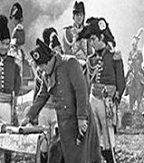 On December 30th, the main French army began crossing the Esla River, and Marshal Soult
entered Leon. Napoleon pushed forward. Unfortunately the cares of his vast empire were
plucking at his coattails. He received news of political intrigues at Paris and that Austria
was again mobilising her large army.
On December 30th, the main French army began crossing the Esla River, and Marshal Soult
entered Leon. Napoleon pushed forward. Unfortunately the cares of his vast empire were
plucking at his coattails. He received news of political intrigues at Paris and that Austria
was again mobilising her large army.
On January 1st, the Emperor left Benavente, still hopeful that Moore would stand at
Astorga. Some distance from Astorga, a messenger from Paris overtook him: Austria seemed
on the verge of declaring war; Fouche and Talleyrand were deep in intrigues against him;
The Emperor was needed in France. On January 17th he began a breakneck ride for Paris,
arriving there on the 24th. Before leaving, Napoleon announced his decisions:
- the Guard and Lapisse's infantry would return to Benavente
- Ney would concentrate at Astorga
- only Soult (3 infantry divisions, light cavalry, 2 dragoon divisions) would continue the
direct pursuit.
|

 1.
1. 
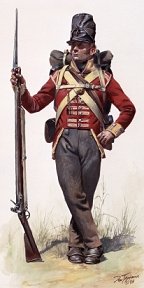 This campaign began as follow: General Moore left a garrison in Lisbon of 10,000 men and
entered Spain with 20,000 to aid the Spanish. His command was to be augmented with
16,000 more under General Baird being sent through Corunna. Moore hoped that his action
will disrupt Napoleon's offensive and draw his attention away from Portugal.
This campaign began as follow: General Moore left a garrison in Lisbon of 10,000 men and
entered Spain with 20,000 to aid the Spanish. His command was to be augmented with
16,000 more under General Baird being sent through Corunna. Moore hoped that his action
will disrupt Napoleon's offensive and draw his attention away from Portugal.
 Sir John Moore (1761-1809) was born in Glasgow.
At the age of 11 joined his father on a tour of France, Italy and Germany, including
a 2-year stay in Geneva, where Moore's education continued. He joined the British
army in 1776 as an ensign in the 51st Foot. Moore first saw action in 1778 during the
American Revolutionary War. In 1798 he was made Major-General and served in the suppression
of the rebellion in Ireland.
Sir John Moore (1761-1809) was born in Glasgow.
At the age of 11 joined his father on a tour of France, Italy and Germany, including
a 2-year stay in Geneva, where Moore's education continued. He joined the British
army in 1776 as an ensign in the 51st Foot. Moore first saw action in 1778 during the
American Revolutionary War. In 1798 he was made Major-General and served in the suppression
of the rebellion in Ireland.
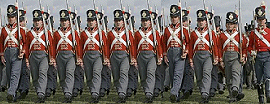 Moore's field army consisted of infantry, cavalry, artillery and engineers.
"They were all, however, volunteers … The average age of the soldiers was 23,
and their average height 5'6". Most had been farm labourers, many from impoverished
villages of Ireland and Scotland. They were paid 1 shilling per day, and led by an
officer corps of aristocrats and gentlemen, many of whom had simply bought their commissions
…" (Summerville - "March of Death" p 26)
Moore's field army consisted of infantry, cavalry, artillery and engineers.
"They were all, however, volunteers … The average age of the soldiers was 23,
and their average height 5'6". Most had been farm labourers, many from impoverished
villages of Ireland and Scotland. They were paid 1 shilling per day, and led by an
officer corps of aristocrats and gentlemen, many of whom had simply bought their commissions
…" (Summerville - "March of Death" p 26)
 "Moore took up his post on 6 Oct, and orders shortly arrived for him to advance into
Leon.... However, the transport and logistical problems that bedevilled all armies in the
Peninsula soon plunged the British commander's calculations into confusion. Moore and
his staff were remarkably ignorant of the geography of the country they were to cross,
and little useful information could be extracted from the Portuguese."
(Gates - "The Spanish Ulcer" p 106)
"Moore took up his post on 6 Oct, and orders shortly arrived for him to advance into
Leon.... However, the transport and logistical problems that bedevilled all armies in the
Peninsula soon plunged the British commander's calculations into confusion. Moore and
his staff were remarkably ignorant of the geography of the country they were to cross,
and little useful information could be extracted from the Portuguese."
(Gates - "The Spanish Ulcer" p 106)
 Pedro Caro y Sureda, 3rd Marqués de la Romana began his military career
in the navy. Jose M. Rodriguez of napoleon-series.org writes: "... Pedro was promoted to ensign and aide to General Moreno. When, in
1779, Spain and Great Britain went to war ... the [Spanish] king ordered an attack to retake
the island of Minorca (in British hands since 1763). A fleet ... with 8,000
soldiers on board, was dispatched to the island. The land forces were under the command of General Moreno,
and so the young Pedro was attached to him. On Feb 5th, 1781, the last British post, the castle of San Felipe,
surrendered ... and Minorca returned to Spanish hands."
Pedro Caro y Sureda, 3rd Marqués de la Romana began his military career
in the navy. Jose M. Rodriguez of napoleon-series.org writes: "... Pedro was promoted to ensign and aide to General Moreno. When, in
1779, Spain and Great Britain went to war ... the [Spanish] king ordered an attack to retake
the island of Minorca (in British hands since 1763). A fleet ... with 8,000
soldiers on board, was dispatched to the island. The land forces were under the command of General Moreno,
and so the young Pedro was attached to him. On Feb 5th, 1781, the last British post, the castle of San Felipe,
surrendered ... and Minorca returned to Spanish hands."
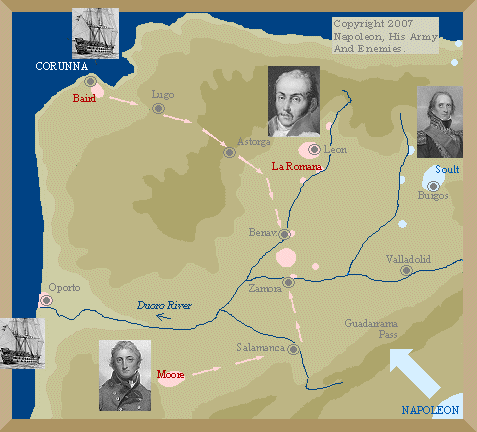 Moore crossed the Douro at Zamora. On Dec 20th he swinged to the left,
linked up with Baird at Mayorga and established contact with La Romana.
Moore crossed the Douro at Zamora. On Dec 20th he swinged to the left,
linked up with Baird at Mayorga and established contact with La Romana.
 Realising what Moore had in mind, the Emperor saw a golden opportunity to swing into his rear,
while Soult contained him frontally. The British army would be encircled and destroyed.
Realising what Moore had in mind, the Emperor saw a golden opportunity to swing into his rear,
while Soult contained him frontally. The British army would be encircled and destroyed.
 In the Sierra Guadarrama the French were struck by a terrible blizzard, the cavalry was forced
to dismount, and when the snow turned to rain the infantrymen were struggling through deep mud.
Coignet remembers fording a freezing river and emerging with his legs "as red as lobsters".
In the Sierra Guadarrama the French were struck by a terrible blizzard, the cavalry was forced
to dismount, and when the snow turned to rain the infantrymen were struggling through deep mud.
Coignet remembers fording a freezing river and emerging with his legs "as red as lobsters".
 Had Moore been at Valladolid, his army would have been destroyed.
It was extremely fortunate for Moore that the Emperor found it as difficult as he did to get
accurate information of enemy movements and that he was 50 miles further than his enemy
supposed.
Had Moore been at Valladolid, his army would have been destroyed.
It was extremely fortunate for Moore that the Emperor found it as difficult as he did to get
accurate information of enemy movements and that he was 50 miles further than his enemy
supposed.
 At Benavente a small French cavalry force was ambushed and defeated by the British and German cavalry.
French General Lefebvre-Desnouettes crossed the river with 600 cavalrymen and impetuously attacked the British and German cavalry.
The enemy at first gave way. General Stewart soon brought in more cavalry. The French continued advancing,
until Lord Paget, accompanied by a hussar regiment forced them to re-cross the river.
The British-German cavalry captured 70-100 prisoners, incl.Lefebvre-Desnouettes.
Despite the moral-boosting success in this small combat, Moore's retreat towards the sea continued.
At Benavente a small French cavalry force was ambushed and defeated by the British and German cavalry.
French General Lefebvre-Desnouettes crossed the river with 600 cavalrymen and impetuously attacked the British and German cavalry.
The enemy at first gave way. General Stewart soon brought in more cavalry. The French continued advancing,
until Lord Paget, accompanied by a hussar regiment forced them to re-cross the river.
The British-German cavalry captured 70-100 prisoners, incl.Lefebvre-Desnouettes.
Despite the moral-boosting success in this small combat, Moore's retreat towards the sea continued.
 Many British units' morale cracked once the headlong retreat began.
Everywhere, Soult's advance guard encountered evidence of the British's mounting
demoralization; the roads were littered with wagons, supplies, equipment, weapons and
scores of stragglers who were captured at every turn.
Many British units' morale cracked once the headlong retreat began.
Everywhere, Soult's advance guard encountered evidence of the British's mounting
demoralization; the roads were littered with wagons, supplies, equipment, weapons and
scores of stragglers who were captured at every turn.
 On December 30th, the main French army began crossing the Esla River, and Marshal Soult
entered Leon. Napoleon pushed forward. Unfortunately the cares of his vast empire were
plucking at his coattails. He received news of political intrigues at Paris and that Austria
was again mobilising her large army.
On December 30th, the main French army began crossing the Esla River, and Marshal Soult
entered Leon. Napoleon pushed forward. Unfortunately the cares of his vast empire were
plucking at his coattails. He received news of political intrigues at Paris and that Austria
was again mobilising her large army.
 Soult was left with only 16,000 infantry and 3,500 cavalry. He pressed Moore hard, but
ran no unnecessary risks. "Moore had previously let it be known that he hoped to make a stand at Astorga and,
upon his arrival, Romana tried to persuade him to hold the mountain passes … in the
rear of the town… The idea was not totally without merit… and 25.000 British troops were
more than enough to defend the two narrow defiles, yet Sir Moore dismissed the possibility
out of hand." (Summerville - p 85)
Soult was left with only 16,000 infantry and 3,500 cavalry. He pressed Moore hard, but
ran no unnecessary risks. "Moore had previously let it be known that he hoped to make a stand at Astorga and,
upon his arrival, Romana tried to persuade him to hold the mountain passes … in the
rear of the town… The idea was not totally without merit… and 25.000 British troops were
more than enough to defend the two narrow defiles, yet Sir Moore dismissed the possibility
out of hand." (Summerville - p 85)
 The French light cavalry under Franceschi bagged some 500 British prisoners on the road.
There were also deserters and sick. Five guns and thousands of muskets intended for Romana's army were dumped in the river at
Betanzos. "Moore lost around 1,000 men on the road from Lugo…"
(Summerville - p 165)
The French light cavalry under Franceschi bagged some 500 British prisoners on the road.
There were also deserters and sick. Five guns and thousands of muskets intended for Romana's army were dumped in the river at
Betanzos. "Moore lost around 1,000 men on the road from Lugo…"
(Summerville - p 165)
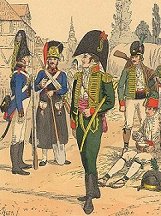 While the British army had to reach Corunna where the Royal Navy was to evacuate them,
La Romana's Spanish troops had no such haven to run to. Soon the British and Spanish troops
separated. Soult sent Francesci's cavalry after La Romana who fell on the Spanish rear
guard at the Foncebabon Pass and captured 1,500 prisoners. Romana had planned to withdraw
northward into Asturias. Now, finding the passes there blocked with snow, he turned toward
Astorga, crowding in on Moore's withdrawal. In Astorga "many British soldiers took to
prowling the streets in search of alcohol. ..
While the British army had to reach Corunna where the Royal Navy was to evacuate them,
La Romana's Spanish troops had no such haven to run to. Soon the British and Spanish troops
separated. Soult sent Francesci's cavalry after La Romana who fell on the Spanish rear
guard at the Foncebabon Pass and captured 1,500 prisoners. Romana had planned to withdraw
northward into Asturias. Now, finding the passes there blocked with snow, he turned toward
Astorga, crowding in on Moore's withdrawal. In Astorga "many British soldiers took to
prowling the streets in search of alcohol. ..
 The British troops who finally reached Corunna were in very poor state.
"The people of Corunna, however, were inspired with nothing but pity at the sight of
Moore's army. In fact, so shocked and appalled were they at this procession of spectres-men
hollowed out by hardships … that they made sign of cross as the soldiers passed."
(Summerville - p 169)
The British troops who finally reached Corunna were in very poor state.
"The people of Corunna, however, were inspired with nothing but pity at the sight of
Moore's army. In fact, so shocked and appalled were they at this procession of spectres-men
hollowed out by hardships … that they made sign of cross as the soldiers passed."
(Summerville - p 169)
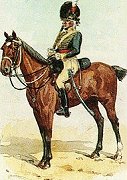 Less than 1,000 horses went with them. The rest had to be killed.
Less than 1,000 horses went with them. The rest had to be killed. One of Soult's divisional commanders was Henri-Francois Delaborde (1764-1833). Delaborde was son of a baker and
was educated for the church. He was a leanly big man and spoke Latin language. According to Colonel Elting "he said little,
but what he said was very definite." In the beginning of the French Revolution he joined the volunteers and passing rapidly
through all the junior grades was made general of brigade after the battle of Rhein-Zabern (1793). He was present at the
siege of Toulon and promoted general of division. In 1807 Delaborde was training new conscripts at his camp at Pontivy in
France.
One of Soult's divisional commanders was Henri-Francois Delaborde (1764-1833). Delaborde was son of a baker and
was educated for the church. He was a leanly big man and spoke Latin language. According to Colonel Elting "he said little,
but what he said was very definite." In the beginning of the French Revolution he joined the volunteers and passing rapidly
through all the junior grades was made general of brigade after the battle of Rhein-Zabern (1793). He was present at the
siege of Toulon and promoted general of division. In 1807 Delaborde was training new conscripts at his camp at Pontivy in
France.
 One of Moore's divisional commanders was Lord Paget (later Lord Uxbridge, and subsequently Marquis of Anglesey).
Henry Paget was not only an excellent officer but also a womanizer. When he decided to elope with Wellington's sister-in-law
(and got her pregnant, before returning her to a tearful husband only to elope for a second time, forcing a parliamentary
divorce and then marrying the lady), the military establishment in London wrongly supposed that his talents were no longer
required by Wellington because of the scandal. Lord Paget was a brave man, and well known general.
One of Moore's divisional commanders was Lord Paget (later Lord Uxbridge, and subsequently Marquis of Anglesey).
Henry Paget was not only an excellent officer but also a womanizer. When he decided to elope with Wellington's sister-in-law
(and got her pregnant, before returning her to a tearful husband only to elope for a second time, forcing a parliamentary
divorce and then marrying the lady), the military establishment in London wrongly supposed that his talents were no longer
required by Wellington because of the scandal. Lord Paget was a brave man, and well known general.
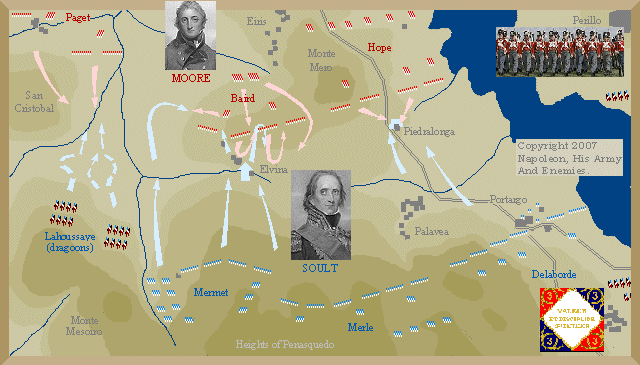
 Picture: Highlanders in combat, by Dmitrii Zgonnik of Ukraine.
Picture: Highlanders in combat, by Dmitrii Zgonnik of Ukraine.
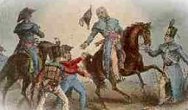 Hardinge galloped up to report the Guards' arrival. Moore looked in the direction in which
Hardinge was pointing and was suddenly thrown from his saddle. He fell on his back at the feet
of Colonel Graham's horse. A round-shot had torn a hole so deep in his left shoulder
that the lung was exposed, the ribs over the heart and part of the collar-bone had been
smashed, the muscles of the breast had been torn into strips and the arm was hanging only
by the sleeve of his coat and a shred of flesh.
Hardinge galloped up to report the Guards' arrival. Moore looked in the direction in which
Hardinge was pointing and was suddenly thrown from his saddle. He fell on his back at the feet
of Colonel Graham's horse. A round-shot had torn a hole so deep in his left shoulder
that the lung was exposed, the ribs over the heart and part of the collar-bone had been
smashed, the muscles of the breast had been torn into strips and the arm was hanging only
by the sleeve of his coat and a shred of flesh.
 Moore mortally wounded, died that night, while Hope pressed the embarkation.
Benjamin Miller writes: "As we drifted down the harbour we saw hundreds of our soldiers,
which had been doing duty in the garrison, sitting on the rocks by the water's side …
waving their hats and calling for the boats to take them off …"
The British had almost finished the embarkation by morning, when French artillery came
into action from cliffs overlooking the bay.
James Moore writes: "Towards 8 o'clock in the morning some firing was heard…"
The firing heard by the mourners at Moore's graveside had been occasioned by a
French advance.
Moore mortally wounded, died that night, while Hope pressed the embarkation.
Benjamin Miller writes: "As we drifted down the harbour we saw hundreds of our soldiers,
which had been doing duty in the garrison, sitting on the rocks by the water's side …
waving their hats and calling for the boats to take them off …"
The British had almost finished the embarkation by morning, when French artillery came
into action from cliffs overlooking the bay.
James Moore writes: "Towards 8 o'clock in the morning some firing was heard…"
The firing heard by the mourners at Moore's graveside had been occasioned by a
French advance.
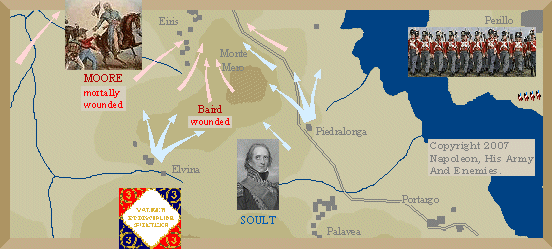 The French became the masters of the battlefield and
Soult had begun closing in on Corunna. The fire created confusion on the British side.
Cpt. Gordon writes: "The French … opened a cannonade upon the shipping in the harbour,
which caused great confusion amongst the transports. Many were obliged to cut their
cables, some suffered damage by running foul of each other, and 5 or 6 were abandoned by
their crews and drifted on shore." In fact, 4 transports ran aground, 3 of which had to be burned, their cargo of men ferried
to other vessels in the harbour in a confused operation, during which some men were drowned.
A young Spanish girl said to August Schaumann: "Oh how lucky you English are to have your
ships and to be able to get away !"
The French became the masters of the battlefield and
Soult had begun closing in on Corunna. The fire created confusion on the British side.
Cpt. Gordon writes: "The French … opened a cannonade upon the shipping in the harbour,
which caused great confusion amongst the transports. Many were obliged to cut their
cables, some suffered damage by running foul of each other, and 5 or 6 were abandoned by
their crews and drifted on shore." In fact, 4 transports ran aground, 3 of which had to be burned, their cargo of men ferried
to other vessels in the harbour in a confused operation, during which some men were drowned.
A young Spanish girl said to August Schaumann: "Oh how lucky you English are to have your
ships and to be able to get away !"
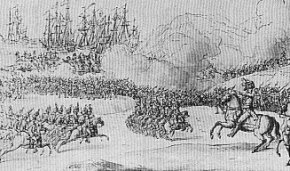 In four or five days the fleet carried home about 26,000 men of Moore's army.
Corunna's defences were left in the hands of its small Spanish garrison under the command
of General Alcedo. Alcedo would fend off the French just long enough for the British to
depart. Officer of the French Hussars writes: "The town of Corunna, surorunded by
fortifications, was defended by its inhabitants and only capitulated on the 20th."
(de Rocca, - p 66)
In four or five days the fleet carried home about 26,000 men of Moore's army.
Corunna's defences were left in the hands of its small Spanish garrison under the command
of General Alcedo. Alcedo would fend off the French just long enough for the British to
depart. Officer of the French Hussars writes: "The town of Corunna, surorunded by
fortifications, was defended by its inhabitants and only capitulated on the 20th."
(de Rocca, - p 66)
 After the victory at Corunna, Soult took the great naval base of El Ferrol.
He captured 8 battle-ships, 3 frigates, several hundred prisoners and enormous equipment
stockpiles, incl. 20,000 British muskets.
After the victory at Corunna, Soult took the great naval base of El Ferrol.
He captured 8 battle-ships, 3 frigates, several hundred prisoners and enormous equipment
stockpiles, incl. 20,000 British muskets.
 In contrast to the media, politicians, and many military men in 1809, today some British historians
consider Corunna as victory. They like to portray hard-fought retreats and withdrawals like
Corunna or Dunkirk as triumphs. For example Summerville writes: "In short the British ... were not in a position to exploit their success with an offensive,
the redcoats secured their embarkation, and thus claimed the Battle of Corunna as a victory."
In contrast to the media, politicians, and many military men in 1809, today some British historians
consider Corunna as victory. They like to portray hard-fought retreats and withdrawals like
Corunna or Dunkirk as triumphs. For example Summerville writes: "In short the British ... were not in a position to exploit their success with an offensive,
the redcoats secured their embarkation, and thus claimed the Battle of Corunna as a victory."

